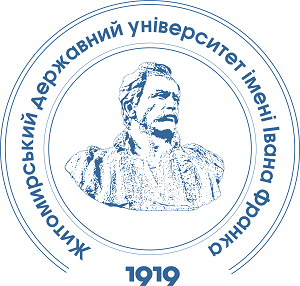FAUNA OF EARTHWORMS IN THE URBANIZED BIOTOPES OF THE CITY OF ZHYTOMYR
DOI:
https://doi.org/10.32782/naturaljournal.11.2025.7Keywords:
Lumbricidae, species composition, biodiversity, urban ecosystemAbstract
Today, urbanization is one of the main threats to biodiversity, and monitoring the fauna of urbanized areas provides valuable information about the impact of the human-transformed environment onthe diversity of biota. Since earthworms are one of the most common representatives of pedofauna and are in constant contact with the soil, they sensitively react to negative changes in its conditionand are an indicator of the quality of the environment. The article presents the results of a studyof the species composition and structure of earthworm complexes in the urban ecosystem of the cityof Zhytomyr. It was established that the fauna of earthworms in the studied biotopes of the city includes ten species of the Lumbricidae family: Aporrectodea caliginosa (Savigny, 1826), A. rosea (Savigny, 1826), A. trapezoides (Dugesi, 1828), Lumbricus terrestris (Linnaeus, 1758), L. castaneus (Savigny, 1826), L. rubellus (Savigny, 1826), Dendrobaena octaedra (Savigny, 1826), Octolasion lacteum (Örley, 1885), Eiseniella tetraedra (Savigny, 1826) and Eisenia fetida (Savigny, 1826). The identified species have a different set of morphological adaptations to life in the soil environment and are unevenly represented in the samples. The background species are A. caliginosa, A. rosea and L. terrestris,which are represented in the vast majority of samples. A. caliginosa turned out to be the most numerous in the investigated recreational areas, but it reaches the greatest number in the centralpark areas of the city. In some samples, L. terrestris is dominant or co-dominant. A. rosea reaches its greatest abundance in recreational zones near the shores of reservoirs, while in central park zones itis represented only by single specimens. Other species do not reach high numbers here. In the yardsof residential buildings and near them, the maximum number of identified lumbricides in individual samples reached 8 individuals per sample – in the vast majority of samples (92,45%) A. caliginosa was dominant, in 7,55% of samples – A. rosea. In the studied biocenoses, located near industrial enterprises, the number of detected species of earthworms was insignificant.
References
Білецький Ю.В. Угруповання ґрунтової мезофауни соснових лісів Шацького національного природного парку та їх антропогенні зміни : дис. … канд. біол. наук : 03.00.16. Львів, 2016. 160 с.
Біоіндикаційна оцінка стану паркових екосистем міста Києва / Н.В. Мірошник та ін. Київ : Академперіодика, 2023. 200 с. https://doi.org/10.15407/akademperiodyka.488.200.
Войчун Н.І., Андрейчук Ю.М., Жданюк Б.С. Антропогенний вплив на природне середовище. Людина та довкілля. Проблеми неоекології. 2016. № 1–2 (25). С. 77–82.
Гарбар О.В., Мороз В.В., Гарбар Д.А., Ворончук Л.І., Даниловська Н.Д. Структура угрупувань дощових червів в урбанізованих біотопах Центрального Полісся. GEO & BIO. 2023. Т. 24. С. 173–182. https://doi.org/10.15407/gb2412.
Гунько С.О. Кадмій у ґрунтах м. Дніпродзержинськ. Вісник Дніпропетровського університету. Біологія. Медицина. 2011. № 2. Т. 1. С. 24–30. https://doi.org/10.15421/021104.
Жуков О.В., Пахомов О.Є., Кунах О.М. Біологічне різноманіття України. Дніпропетровська область. Дощові черв’яки (Lumbricidae) : монографія / за заг. ред. проф. О.Є. Пахомова. Дніпропетровськ : Дніпропетровський національний університет, 2007. 371 с.
Криштоп Є.А., Волощенко В.В. Міські ґрунти як невід’ємний елемент урбанізованих і техногенно забруднених територій. Вісник Харківського національного аграрного університету імені В.В. Докучаєва. 2013. № 2. С. 200–206.
Маловічко О.В., Головня Ю.П. Екологічний аналіз наслідків стану забруднення автомагістралей Києва. Вісник Національного авіаційного університету. 2008. Т. 37. № 4. С. 89–92. https://doi.org/10.18372/2306-1472.37.1639.
Мірзак О.В. Екологічні особливості едафотопів урбанізованих територій степової зони України (на прикладі м. Дніпропетровська) : автореф. дис. … канд. біол. наук : 03.00.16. Дніпропетровськ, 2001. 19 с.
Стернік В.М. Біотична активність урбоедафотопів міста Рівне : дис. … канд. біол. наук : 03.00.16. Рівне, 2017. 179 с.
Стернік В.М., Мельник В.Й. Актуальність досліджень дощових черв’яків у біоіндикації стану урбоедафотопів міста Рівне. Збірник наукових праць Харківського національного педагогічного університету імені Г.С. Сковороди. Біологія та валеологія. 2016. № 18. С. 169–180. https://doi.org/10.5281/zenodo.167417.
Стойко С.М., Койнова І.Б. Сучасні види антропогенного впливу на життєве середовище. Український географічний журнал. 2012. № 1. С. 50–57.
Тітенко Г.В. Оцінка екологічного стану міських ґрунтів як засіб оптимізації території. Вісник Сумського державного університету. Технічні науки. 2006. № 5 (89). С. 149–152.
Шаталін Д.Б. Дощові черв’яки (Lumbricidae) лісових та урбоекосистем Степового Придніпров’я: структурно-функціональна організація угруповань та екологічні аспекти вермикультури : дис. … канд. с.-г. наук : 03.00.16. Дніпро, 2017. 187 с.
Caruso T., Migliorini M., Rota E., Bargagli R. Highly diverse urban soil communities: Does stochas-ticity play a major role? Applied Soil Ecology. 2017. Vol. 110. P. 73–78. https://doi.org/10.1016/j.apsoil.2016.10.012.
Concepción E.D., Moretti M., Altermatt F., Nobis M.P., Obrist M.K. Impacts of urbanisation on biodiversity: the role of species mobility, degree of specialisation and spatial scale. Oikos. 2015. Vol. 124. № 12. P. 1571–1582. https://doi.org/10.1111/oik.02166.
Curry J. Factors Affecting the Abundance of Earthworms in Soils. Earthworm ecology. 2004. Vol. 9. P. 91–113. https://doi.org/10.1201/9781420039719.pt3.
Eggleton P., Inward K., Smith J., Jones D.T., Sherlock E. A six-year study of earthworm (Lumbricidae) populations in pasture woodland in southern England shows their responses to soil temperature and soil moisture. Soil Biology and Biochemistry. 2009. Vol. 41. P. 1857–1865. https://doi.org/10.1016/j.soilbio.2009.06.007.
Ernst G., Zimmermann S., Christie P., Frey B. Mercury, cadmium and lead concentra-tions in different ecophysiological groups of earthworms in forest soils. Environmental Pollution. 2008. Vol. 156. P. 1304–1313. https://doi.org/10.1016/j.envpol.2008.03.002.
Fründ H.-C., Egbert E., Dumbeck G. Spatial distribution of earthworms [Lumbricidae] in reculti-vated soils of the Rhenish lignite-mining area, Germany. Journal of Plant Nutrition and Soil Science. 2004. Vol. 167. Iss. 4. P. 494–502. https://doi.org/10.1002/jpln.200421372.
Fründ H.-C., Graefe U., Tischer S. Earthworms as Bioindicators of Soil Quality. Biology of Earthworms. 2010. Vol. 24. P. 261–278. https://doi.org/10.1007/978-3-642-14636-7_16.
Grimm N.B., Faeth S.H., Golubiewski N.E., Redman C.L., Wu J., Bai X., Briggs J.M. Global change and the ecology of cities. Science. 2008. Vol. 319. P. 756–760. https://doi.org/10.1126/science.1150195.
Harbar O., Moroz V., Harbar D., Vyskushenko D., Kratiuk O. Spatial variation of earth-worm communities in the motorway proximity. Studia Biologica. 2024. № 18 (2). P. 157–168. https://doi.org/10.30970/sbi.1802.768.
Joschko M., Fox C.A., Lentzsch P., Kiesel J., Hierold W., Krück S., Timmer J. Spatial analysis of earthworm biodiversity at the regional scale. Agriculture, Ecosystems & Environment. 2006. Vol. 112. № 4. P. 367–380. https://doi.org/10.1016/j.agee.2005.08.026.
Lanno R., Wells J., Conder J., Basta N. The Bioavailability of Chemicals in Soil for Earthworms. Ecotoxicology and Environmental Safety. 2004. Vol. 57. № 1. P. 39–47. https://doi.org/10.1002/chin.200418292.
Morgan J.E., Morgan A.J. The accumulation of metals (Cd, Cu, Pb, Zn and Ca) by two eco-logically contrasting earthworm species (Lumbricus rubellus and Aporrectodea caliginosa): implications for ecotoxicological testing. Applied Soil Ecology. 1999. Vol. 13. № 1. P. 9–20. https://doi.org/10.1016/S0929-1393(99)00012-8.
Ooms A., Dias A.T.C., Oosten van A.R., Cornelissen J.H.C., Ellers J., Berg M.P. Species richness and functional diversity of isopod communities vary across an urbanisation gradient, but the direc-tion and strength depend on soil type / A. Ooms et al. Soil Biology and Biochemistry. 2020. Vol. 148. Р. 107851. https://doi.org/10.1016/j.soilbio.2020.107851.
Paoletti M.G. The role of earthworms for assessment of sustainability and as bioindicators. Agriculture, Ecosystems & Environment. 1999. Vol. 74. № 1–3. P. 137–155. https://doi.org/10.1016/S0167-8809(99)00034-1.
Peijnenburg W.J.G.M., Vijver M.G. Earthworms and Their Use in Eco(toxico)logical Modeling. Ecotoxicology Modeling. 2009. P. 177–204. https://doi.org/10.1007/978-1-4419-0197-2_7.
Römbke J., Jänsch S., Didden W. The use of earthworms in ecological soil classification and assessment concepts. Ecotoxicology and Environmental Safety. 2005. Vol. 62. № 2. P. 249–265. https://doi.org/10.1016/j.ecoenv.2005.03.027.
Sheehan C., Kirwan L., Connoll J., Bolger T. The effects of earthworm functional group diversity on nitrogen dynamics in soils. Soil Biology and Biochemistry. 2006. Vol. 38. № 9. P. 2629–2636. https://doi.org/10.1016/j.soilbio.2006.04.015.
Spurgeon D.J., Hopkin S.P. Tolerance to Zinc in Populations of the Earthworm Lumbricus rubel-lus from Uncontaminated and Metal-Contaminated Ecosystems. Arch. Environ. Contam. Toxicol. 1999. Vol. 37. № 3. Р. 332–337. https://doi.org/10.1007/s002449900522.
Tischer S. Lumbricidae communities in soil monitoring site differently managed and polluted with heavy metals. Polish Journal of Ecology. 2008. Vol. 56. P. 635–646.
Vlasenko R., Khomiak I., Harbar O., Demchuk N. Lumbricides as a bio-indicators of the influ-ence of electrical transmission line in the conditions of Ukrainian Polissia. Travaux du Muséum National d’Histoire Naturelle “Grigore Antipa”. 2020. № 63 (1). Р. 7–18. https://doi.org/10.3897/travaux.63.e51640.






